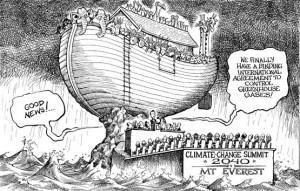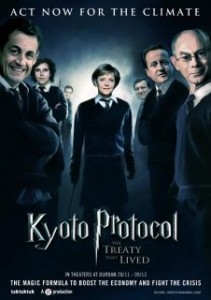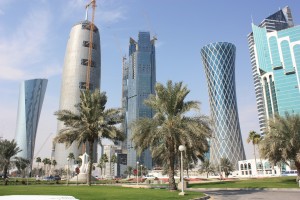From Durban to Doha: Opportunities and Challenges Ahead for the International Climate Regime
As the dust finally settled down after the chaotic end to COP17 in Durban, South Africa last month, it was only normal to welcome perspectives from both sides of the spectrum. On one corner, we have supporters of the Durban package who see it as a ‘historic landmark’ deal that has set the future course of climate regime, therefore a success. On the other end, we have critics according to whom Durban represents a complete U-turn from Rio principles of historical responsibility ‘based on common but differentiated responsibilities and respective capabilities (CBDRRC)’, hence a failure. Many other opinions exist in between too. But one thing which everyone seems to agree on is that the Durban outcome is largely insufficient to prevent the two degree Celsius temperature rise of the planet, which the scientists say is the maximum limit. It also hints to a stringent reality of how politically difficult it is to reach a comprehensive global agreement even in the times of catastrophic climatic events.
Yes, Durban outcome is not credible, or perfect. It is also true that many important issues are left to stand as they happen to be and decision is still pending on them. Moreover, the burden of major emitters has also been shifted onto developing countries, which is against the principles of equity and CBDR. But to label the Durban outcome as a complete failure is not coherent– there are opportunities in it too that can bring us closer to a political or technological solution. Of course, Durban outcome has also given rise to many challenges, and this year we will see some heated action in climate talks to address these until their climax scheduled to happen at COP18 in Doha, Qatar by the end of the year. Here’s a brief look at what opportunities and challenges are in store this year for the international climate regime:
Opportunities
The good news is that many important developments have occurred since past year, which gives us hope that progress can be made in international negotiations on climate change, no matter how slow and incremental. New institutions have been created, some outstanding issues have been resolved, and new ideas have emerged to tackle climate change.
Durban Platform for Enhanced Action (DPEA)
 The establishment of an Ad Hoc Working Group on Durban Platform for Enhanced Action (AWG-DPEA) is considered to be one of the major outcomes of COP17. It has been given the mandate to ‘develop a protocol, another legal instrument or an agreed outcome with legal force applicable to all parties’ to be adopted by 2015 and implemented by 2020. This means that this year, negotiations will happen in an additional track to plan and finalize work relating mitigation, adaptation, finance, technology, transparency, and capacity building that will serve as the building blocks of the new treaty (hopefully).
The establishment of an Ad Hoc Working Group on Durban Platform for Enhanced Action (AWG-DPEA) is considered to be one of the major outcomes of COP17. It has been given the mandate to ‘develop a protocol, another legal instrument or an agreed outcome with legal force applicable to all parties’ to be adopted by 2015 and implemented by 2020. This means that this year, negotiations will happen in an additional track to plan and finalize work relating mitigation, adaptation, finance, technology, transparency, and capacity building that will serve as the building blocks of the new treaty (hopefully).
Green Climate Fund
For the past three years, negotiators were talking about setting up a fund that could help developing countries adapt and mitigate to the impacts of climate change. In Durban last year, the decision to set up a Green Climate Fund was finalized. What remain to be seen this year is when exactly this Fund will become operational and how money will be mobilized for it.
2nd Commitment Period of Kyoto Protocol
There is now an agreement over a 2nd commitment period (2CP) of the Kyoto Protocol (KP), which will take effective from January 2013 when its first commitment period expires this year. This is important since Kyoto Protocol is the only legal instrument we have to tackle climate change globally. Although it has some shortcomings, nonetheless, KP is crucial for the international climate order as it encompasses several important areas such as CDMs, LULUCF, emission reduction targets by Annex 1 countries, along with tools, policies, and measures to address climate change.
Rio+20
 2012 will also host the Rio+20 Summit that aims to address the issues of significant importance such as poverty and development. The Summit will try to convene global political attention towards the need for policy interventions and institutional framework for the areas of environment and development, now known as sustainable development. It will ensure that the global development remains possible and permanent without undermining the ecological aspects of humanity. Moreover, the Summit will try to put a meaning to the already elusive terms such as ‘sustainable development’ and ‘Green Economy’, along with developing a global deal for it.
2012 will also host the Rio+20 Summit that aims to address the issues of significant importance such as poverty and development. The Summit will try to convene global political attention towards the need for policy interventions and institutional framework for the areas of environment and development, now known as sustainable development. It will ensure that the global development remains possible and permanent without undermining the ecological aspects of humanity. Moreover, the Summit will try to put a meaning to the already elusive terms such as ‘sustainable development’ and ‘Green Economy’, along with developing a global deal for it.
National and Sub-national Approaches
In response to great urgency to tackle climate change, many countries have started taking individual steps as per their respective capabilities to address climate issues locally. This is good since now climate change has started to garner interest from various segments. In Pakistan, for instance, officials are talking about establishing or reinstating institutions that can work on climate issues. There are even talks of working with political parties to incorporate ‘Green Agenda’ in their political manifestos, and to bring policies into force through legislative authority.
Challenges
Unfortunately, the bad news is that there are more challenges this year than the opportunities that exist. The issues have gotten more complex and there are various issues that are left pending, which need to be resolved in 2012.
 Nature of 2CP of Kyoto Protocol
Nature of 2CP of Kyoto Protocol
Even before the end of the first commitment period, Canada has withdrawn itself from the Kyoto Protocol last month. This has some serious implications for the 2CP of the KP as others might follow the suit and not sign to the 2CP. The other challenge lies with finalizing the decisions on proposed KP amendments that were only taken note of and not decided in Durban. These include specific targets for Annex 1 parties that are ambitious and quantifiable and timeline of the 2CP.
Legally Binding Treaty Post-KP?
An overarching challenge for future climate negotiations is to determine and define the actual nature of the global pact that will replace KP, and whether it will be legally binding. The decision on it will supposedly be blocked and/or delayed by the major emitters. In fact, the inclusion of the phrase “agreed outcome with legal force” is seen by many as a way to postpone talks on the legally binding nature of the prospective pact by the major emitters (US is rumoured to be the brain behind the term, supported by Brazil). All in all, it is unlikely that a decision regarding the issue will be finalized this year.
Outstanding Issues of the LCA
The Ad Hoc Working Group on Long-term Cooperative Action (AWG-LCA) completed most of its work at COP17 in Durban. However, there are many issues that are still pending. This year, the AWG-LCA will work on finalizing issues pertaining to shared vision, long-term finance, mitigation, and review. The challenge is to see if the AWG-LCA completes its mandate before its conclusion at COP18 or if it gives rise to newer issues that require more time and discussions to be resolved.
Political Momentum
An important aspect of Durban is that it represents a breakthrough at least on the political level. For the first time, developed and developing countries both agreed to share the responsibility of controlling GHGs emissions to tackle global warming. But the challenge is to see how long and how far will this political momentum last. 2012 also being the elections year in many countries, including the US, EU, and Pakistan, will see a shift in policies relating climate change and the environment in these countries.
The question in everyone’s mind is whether 2012 will be any better for the international climate regime. Will we be able to resolve outstanding issues and move closer to our objective? Or will we just delay the things further and bear the costs of inaction? Whatever happens, let’s hope that we do something before the world ends in 2012.




-
http://twitter.com/jrwiese joshua wiese
-
Farrukh Zaman
-
http://www.italiaclima.org/ Federico
About the author
Farrukh Zaman
Farrukh is a climate activist and researcher from Karachi, Pakistan, where he spearheaded a youth movement on climate change.






